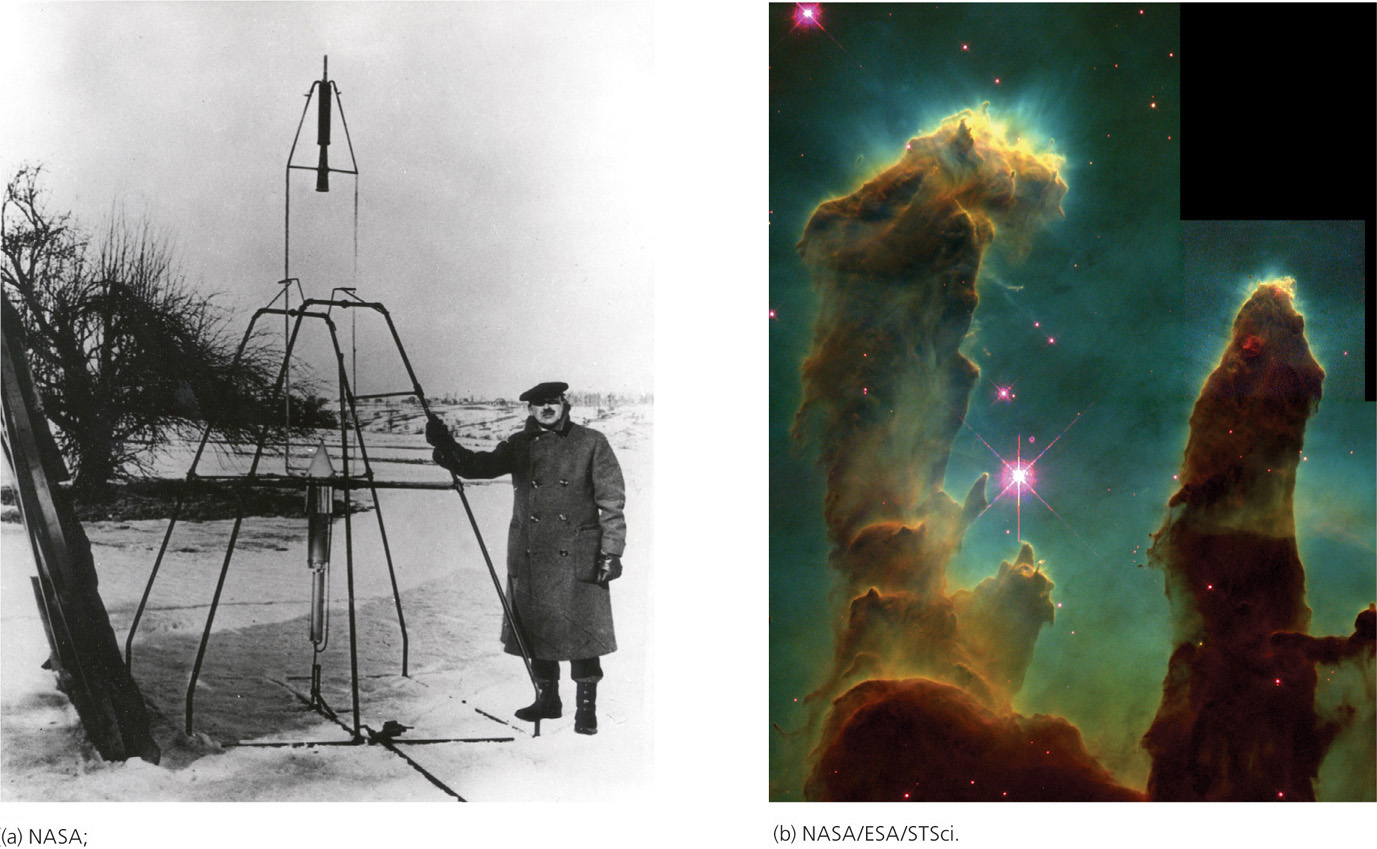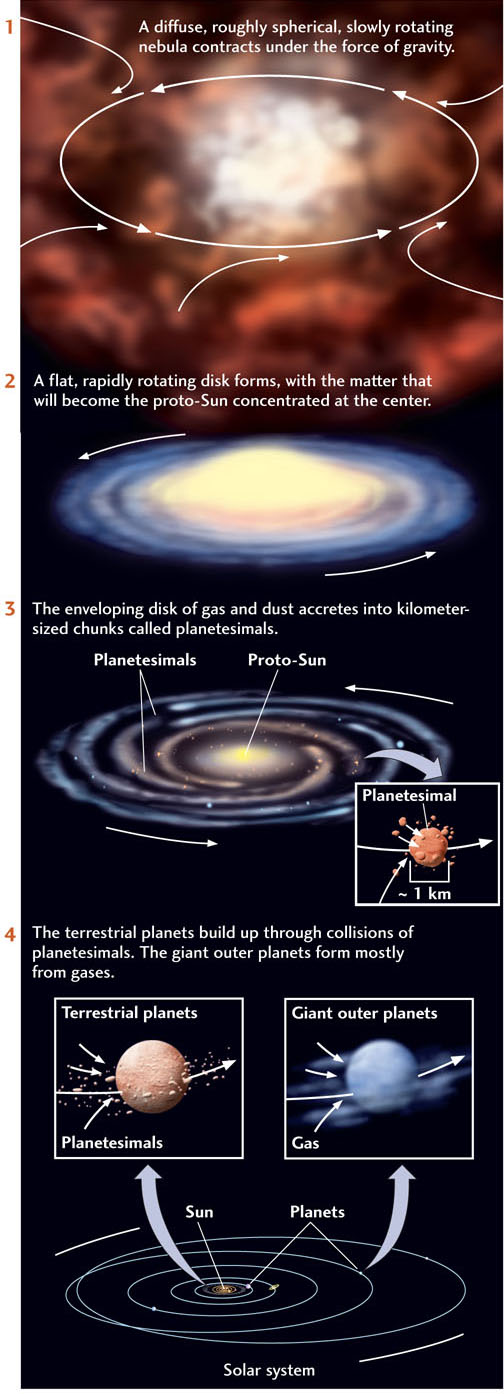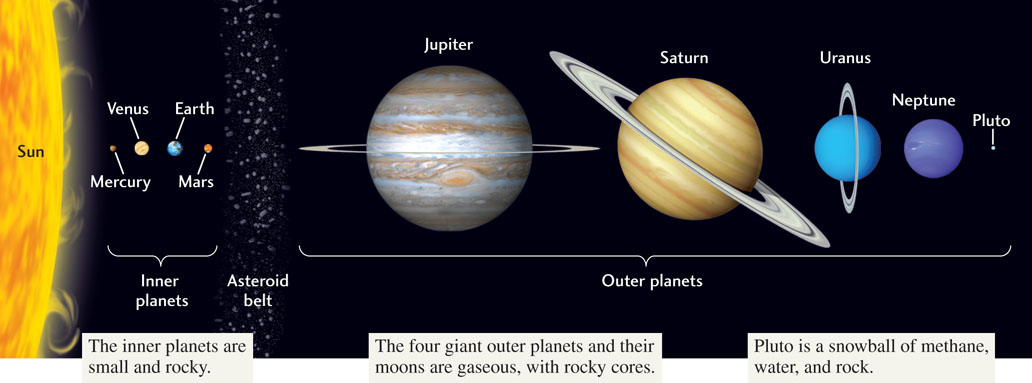Origin of the Solar System
Our search for the origins of the universe—and of our own small part of it—goes back to the earliest recorded mythologies. Today, the generally accepted scientific explanation is the Big Bang theory, which holds that our universe began about 13.7 billion years ago with a cosmic “explosion.” Before that moment, all matter and energy were compacted into a single, inconceivably dense point. Although we know little of what happened in the first fraction of a second after time began, astronomers have a general understanding of the billions of years that followed: in a process that still continues, the universe has expanded and thinned out to form galaxies and stars. Geology explores the latter third of that time: the past 4.5 billion years, during which our solar system—the star we call the Sun and the planets that orbit it—formed and evolved. In particular, geologists look to the solar system to understand the formation of Earth and the Earthlike planets.
The Nebular Hypothesis
In 1755, the German philosopher Immanuel Kant suggested that the origin of the solar system could be traced to a rotating cloud of gases and fine dust, an idea called the nebular hypothesis. We now know that outer space beyond the solar system is not as empty as we once thought. Astronomers have recorded many clouds of the type that Kant surmised, which they have named nebulae (plural of the Latin word for “fog” or “cloud”) (Figure 9.1). They have also identified the materials that form these clouds. The gases are mostly hydrogen and helium, the two elements that make up all but a small fraction of our Sun. The dust-sized particles are chemically similar to materials found on Earth.
223

How could the solar system take shape from such a cloud? The diffuse, slowly rotating nebula contracted under the force of gravity (Figure 9.2). Its contraction, in turn, accelerated the rotation of the particles (just as ice skaters spin more rapidly when they pull in their arms), and the faster rotation flattened the cloud into a disk.

The Sun Forms
Under the pull of gravity, matter began to drift toward the center of the nebula, accumulating into a protostar, the precursor of our present Sun. Compressed under its own weight, the material in the proto-Sun became dense and hot. Its internal temperature rose to millions of degrees, at which point nuclear fusion began. The Sun’s nuclear fusion, which continues today, is the same nuclear reaction that occurs in a hydrogen bomb. In both cases, hydrogen atoms, under intense pressures and at high temperatures, combine (fuse) to form helium. Some mass is converted into energy in the process. The Sun releases some of that energy as sunshine; an H-bomb releases it as an explosion.
The Planets Form
Although most of the matter in the original nebula was concentrated in the proto-Sun, a disk of gases and dust, called the solar nebula, remained to envelop it. The temperature of the solar nebula rose as it flattened into a disk. It became hotter in the inner region, where more of the matter accumulated, than in the less dense outer regions. Once formed, the disk began to cool, and many of the gases condensed—that is, they were transformed to their liquid or solid state, just as water vapor condenses into droplets on the outside of a cold glass and water solidifies into ice when it cools below the freezing point.
Gravitational attraction caused the dust and condensing material to clump together (accrete) into small, kilometer-sized chunks, or planetesimals. These planetesimals, in turn, collided and stuck together, forming larger, Moon-sized bodies (see Figure 9.2). In a final stage of cataclysmic impacts, a few of these larger bodies—with their stronger gravitational attraction—swept up the others to form the planets in their present orbits. Planetary formation happened rapidly, probably within 10 million years after the condensation of the nebula.
224
As the planets formed, those in orbits close to the Sun and those in orbits farther from the Sun developed in markedly different ways. Thus, the composition of the inner planets is quite different from that of the outer planets.
Terrestrial Planets
The four inner planets, in order of closeness to the Sun, are Mercury, Venus, Earth, and Mars (Figure 9.3). They are also known as the Earthlike planets, or terrestrial planets. They formed close to the Sun, where conditions were so hot that most of their volatile materials (those that most easily become gases) boiled away. Radiation and matter streaming from the Sun—the solar wind—blew away most of the hydrogen, helium, water, and other light gases and liquids on these planets. Thus, the inner planets were formed mainly from the dense matter that was left behind, which included the rock-forming silicates as well as metals such as iron and nickel. From isotopic dating of the meteorites that occasionally strike Earth, which are believed to be remnants of this pre-planetary process, we know that the inner planets began to accrete about 4.56 billion years ago (see Chapter 8). Computer simulations indicate that they would have grown to planetary size in a remarkably short time—perhaps as quickly as 10 million years or less.

Giant Outer Planets
Most of the volatile materials swept from the region of the terrestrial planets were carried to the cold outer reaches of the solar system to form the giant outer planets—Jupiter, Saturn, Uranus, and Neptune—and their satellites. These giant planets were big enough, and their gravitational attraction strong enough, to enable them to hold onto the lighter nebular materials. Thus, although they have rocky and metal-rich cores, they, like the Sun, are composed mostly of hydrogen and helium and the other light materials of the original nebula.
Small Bodies of the Solar System
Not all the material from the solar nebula ended up in planets. Some planetesimals collected between the orbits of Mars and Jupiter to form the asteroid belt (see Figure 9.3). This region now contains more than 10,000 asteroids with diameters larger than 10 km and about 300 larger than 100 km. The largest is Ceres, which has a diameter of 930 km. Most meteorites—chunks of material from outer space that strike Earth—are tiny pieces of asteroids ejected from the asteroid belt during collisions with one another. Astronomers originally thought the asteroids were the remains of a large planet that had broken apart early in the history of the solar system, but it now appears they are pieces that never coalesced into a planet, probably due to the gravitational influence of Jupiter.
225
Another important group of small, solid bodies is the comets, aggregations of dust and ice that condensed in the cooler outer reaches of the solar nebula. There are probably many millions of comets with diameters larger than 10 km. Most comets orbit the Sun far beyond the outer planets, forming concentric “halos” around the solar system. Occasionally, collisions or near misses throw a comet into an orbit that penetrates the inner solar system. We can then observe it as a bright object with a tail of gases blown away from the Sun by the solar wind. Perhaps the most famous of these is Halley’s Comet, which has an orbital period of 76 years and was last seen in 1986. Comets are intriguing to geologists because they provide clues about the more volatile components of the solar nebula, including water and carbon-rich compounds, which they contain in abundance.